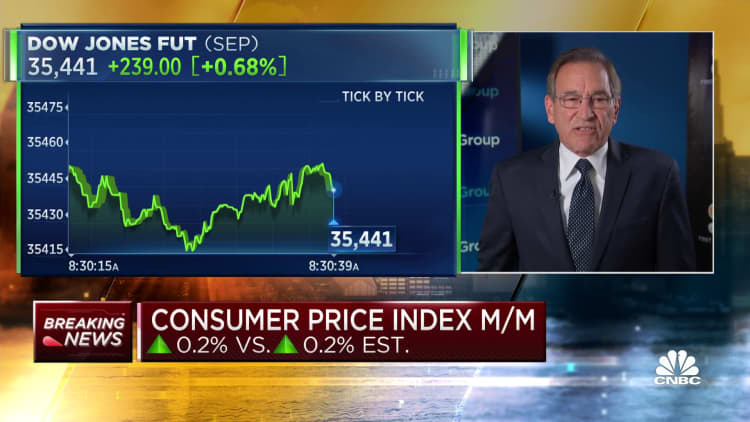
The consumer price index in July marked a 3.2% increase from the previous year, indicating that inflation’s hold on the US economy may be weakening.
Prices rose by a seasonally adjusted 0.2% for the month, aligning with the Dow Jones estimate, according to a report by the Bureau of Labor Statistics released on Thursday. However, the annual rate fell slightly below expectations at 3.3%, although it was higher than June and marked the first increase in over a year.
The core consumer price index, which excludes volatile food and energy prices, also increased by 0.2% for the month, matching estimates. The annual rate for the core CPI stood at 4.7%, the lowest since October 2021, slightly below the Dow Jones consensus estimate of 4.8%.
Markets responded positively to the report, with futures tied to the Dow Jones Industrial Average increasing by over 200 points and Treasury yields mostly declining.
“While we are not yet at the point of declaring ‘mission accomplished,’ significant progress has been made on the inflation front,” stated Sung Won Sohn, chief economist at SS Economics and professor of economics and finance at Loyola Marymount University. “Overall, the inflation picture has seen significant improvements, and the Federal Reserve will soon stop raising interest rates.”
Shelter costs accounted for the majority of the monthly inflation increase, with a 0.4% rise and a 7.7% increase from a year ago. Rents also increased by 0.4%. The Bureau of Labor Statistics reported that this category contributed to over 90% of the overall increase, representing about one-third of the CPI weighting.
Food prices rose by 0.2% during the month, while energy prices increased by just 0.1%, despite a surge in crude oil prices and pump prices.
Used vehicle prices saw a decline of 1.3%, and medical care services decreased by 0.4%. Airline fares fell by 8.1% in July, the same as in June, and are down by 18.6% from a year ago after experiencing a surge during the early days of the Covid pandemic.
“Although prices in certain areas, such as shelter and used cars, are still relatively high, we are witnessing a favorable rate of change that is encouraging for both consumers and Federal Reserve policymakers,” said Rick Rieder, chief investment officer of global fixed income at BlackRock, an asset management giant.

The relatively mild inflation levels have contributed to increased worker pay. According to a separate release by the BLS, real wages rose by 0.3% in the month and were up by 1.1% from a year ago.
The annual inflation rate, although lower than anticipated, actually saw an increase compared to the 3% level in June.
Overall, the latest data indicates that while inflation has significantly decreased from its 40-year highs in mid-2022, it remains well above the Federal Reserve’s desired 2% level. As a result, interest rate cuts are unlikely in the near future.
“While inflation is moving in the right direction, its persistently high level suggests that the Fed is still some distance away from cutting rates,” commented Seema Shah, chief global strategist at Principal Asset Management. “Achieving sustainable disinflation is likely to require further economic adjustments before reaching the 2% target.”
However, the easing inflationary pressures have reduced the urgency for the Fed to continue tightening its monetary policy.
After raising benchmark interest rates 11 times since March 2022, it is widely expected that central bank officials will pause in September. The future course of action remains uncertain, as public statements from policymakers have shown diverging opinions.
While regional Fed Presidents John Williams of New York and Patrick Harker of Philadelphia have suggested an end to rate hikes, Governor Michelle Bowman expects further increases, and Governor Christopher Waller has hinted at the possibility of additional hikes.
Regardless of whether the Fed approves further rate hikes, it is widely believed that the elevated rates will remain in place for an extended period.
Despite the higher rates, economic growth has remained robust, with GDP posting gains of 2% and 2.4% in the first two quarters of 2023, respectively, and the Atlanta Fed projecting third-quarter growth of 4.1%. Although payroll gains have slowed, they are still solid, and unemployment is at its lowest point since late 1969.
Consumers, however, are starting to feel the strain and are increasingly relying on credit cards and savings for their spending. New York Fed data shows that total credit card debt surpassed $1 trillion for the first time this year.
Nevertheless, more economists are now optimistic that the US can avoid a recession despite the aggressive rate hikes. Bank of America, Goldman Sachs, and JPMorgan Chase have recently forecasted a decreased likelihood of a contraction.
Correction: The annual inflation rate was higher than June. An earlier version mischaracterized the historical relationship.
Denial of responsibility! VigourTimes is an automatic aggregator of Global media. In each content, the hyperlink to the primary source is specified. All trademarks belong to their rightful owners, and all materials to their authors. For any complaint, please reach us at – [email protected]. We will take necessary action within 24 hours.


